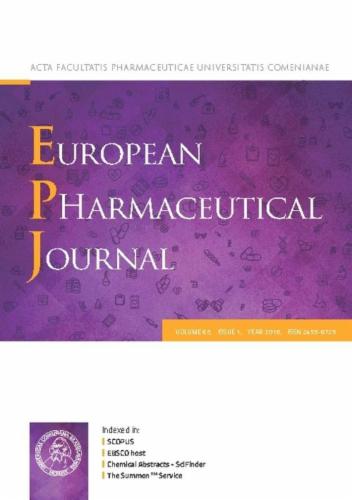吡咯烷SS13诱导结直肠癌细胞氧化应激和自噬介导的细胞死亡。
IF 4.3
3区 医学
Q1 PHARMACOLOGY & PHARMACY
引用次数: 0
摘要
吡咯烷是一种含氮有机化合物,因其具有抗菌、抗病毒、神经学和抗肿瘤作用而成为研究最深入的药物之一。此外,许多药物含有吡咯烷类,如舒尼替尼(抗癌药物)、特拉匹韦和奥姆比他韦(抗病毒药物)或雷米普利(降压药)。研究基础:本研究基于吡咯烷素SS13的促凋亡作用,重点研究所测试的吡咯烷素SS13对结直肠癌细胞的促氧化特性,加深对其作用机制的了解。研究假设:我们假设SS13诱导HCT116和Caco-2细胞系的氧化应激和自噬激活,从而促进抗增殖作用。方法:采用流式细胞术、western blot、荧光显微镜、qRT-PCR等方法评价吡咯烷素SS13的作用。结论及未来研究方向:吡咯烷酮SS13通过在两种细胞系中积累活性氧和活性氮以及调节两种超氧化物歧化酶同工酶(SOD1, SOD2)诱导氧化应激。氧化应激还与DNA损伤反应系统的激活和应激/生存途径的调节有关。我们首次证明,吡啶SS13参与诱导自噬,并伴随自噬标志物(p-AMPK、p-ULK、LC3I/II和ATG7)水平的升高,以及两种细胞系中p62蛋白水平的显著降低。最后,自噬抑制剂氯喹在HCT116和Caco-2细胞中提高了细胞存活率,抑制了SS13的细胞毒作用,表明SS13参与了自噬介导的细胞死亡。综上所述,我们的研究结果表明氧化应激和自噬参与了吡咯烷素SS13对结直肠癌细胞的抗增殖作用。需要进一步研究从不同动物组织中获得的原代细胞培养物以及进行体内实验,以详细了解这些过程,并研究新的吡咯烷衍生物的潜在治疗应用。本文章由计算机程序翻译,如有差异,请以英文原文为准。

Pyrrolidine SS13 induces oxidative stress and autophagy-mediated cell death in colorectal cancer cells
Introduction
Pyrrolidines, nitrogenous organic compounds, are among the most intensively studied agents because of their antibacterial, antiviral, neurological, and promising antitumor effects. Moreover, many medicinal drugs contain pyrrolidine moiety such as sunitinib (anticancer drug), telaprevir and ombitasvir (antiviral drugs) or ramipril (antihypertensive drug).
Rationale of the Study
Based on the pro-apoptotic effect of pyrrolidine SS13, this study focuses on the pro-oxidative properties of the tested pyrrolidine SS13 on colorectal cancer cells to deepen the understanding of its mechanisms of action.
Research hypothesis
We hypothesize that SS13 induces oxidative stress and autophagy activation in HCT116 and Caco-2 cell lines, thus contributing to antiproliferative effects.
Methods
Flow cytometry, western blot, fluorescence microscopy and qRT-PCR were used to evaluate the effect of pyrrolidine SS13.
Conclusion and future directions
Pyrrolidine SS13 induced oxidative stress through the accumulation of reactive oxygen and nitrogen species in both cell lines and the modulation of both superoxide dismutase isoenzymes (SOD1, SOD2). Oxidative stress was also associated with the activation of DNA damage response system and modulation of stress/survival pathways. We demonstrated for the first time that pyrrolidine SS13 is involved in the induction of autophagy accompanied by increased levels of autophagic markers (p-AMPK, p-ULK, LC3I/II and ATG7) and a significant decrease in p62 protein levels in both cell lines. Finally, chloroquine, an inhibitor of autophagy, enhanced cell survival and suppressed the cytotoxic effect of SS13 in HCT116 and Caco-2 cells, indicating that SS13 contributes to autophagy-mediated cell death. Taken together, our results suggest that oxidative stress and autophagy participate in the antiproliferative effect of pyrrolidine SS13 on colorectal cancer cells. Further research using primary cell cultures obtained from different animal tissues as well as performing in vivo experiments is needed to understand these processes in detail and to investigate the potential therapeutic application of new pyrrolidine derivatives.
求助全文
通过发布文献求助,成功后即可免费获取论文全文。
去求助
来源期刊
CiteScore
9.60
自引率
2.20%
发文量
248
审稿时长
50 days
期刊介绍:
The journal publishes research articles, review articles and scientific commentaries on all aspects of the pharmaceutical sciences with emphasis on conceptual novelty and scientific quality. The Editors welcome articles in this multidisciplinary field, with a focus on topics relevant for drug discovery and development.
More specifically, the Journal publishes reports on medicinal chemistry, pharmacology, drug absorption and metabolism, pharmacokinetics and pharmacodynamics, pharmaceutical and biomedical analysis, drug delivery (including gene delivery), drug targeting, pharmaceutical technology, pharmaceutical biotechnology and clinical drug evaluation. The journal will typically not give priority to manuscripts focusing primarily on organic synthesis, natural products, adaptation of analytical approaches, or discussions pertaining to drug policy making.
Scientific commentaries and review articles are generally by invitation only or by consent of the Editors. Proceedings of scientific meetings may be published as special issues or supplements to the Journal.

 求助内容:
求助内容: 应助结果提醒方式:
应助结果提醒方式:


